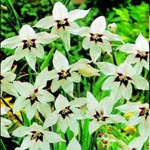Peacock Orchid Growing Guide

What is Peacock Orchid?
Peacock Orchid (Gladiolus murielae) also known as Abyssinian Sword Lily, Abyssinian Star, Fragrant Gladiolus is a herbaceous perennial. It is part of the Iridaceae or iris family and is native to East Africa. The foliage is long sword shaped medium green leaves and forms a clumping habit. Late Summer to early Autumn fragrant white star shape flowers with a purple star center arise on stems to hang just above the foliage line. Plant in a full sun position with organically rich well drained soil that is sheltered from strong winds. Peacock Orchid like the hot afternoon sun, particularly in colder zones.
Benefits of Growing Peacock Orchid
The Peacock Orchid looks stunning when mass planted. These slightly fragrant flowers nodding in the wind will do fantastic in both pots and planted throughout the garden bed. They make ideal cut flowers.
How to Grow Peacock Orchid

Peacock Orchid
Climatic Zones
Cool to sub tropical.
Plant Size
Height: 20-30m, Width: 10-30cm
When To Plant Peacock Orchid
Plant in Spring, once the last frost has passed.
Soil Preparation
They like organically rich well drained soil. Dig through well broken down animal compost or compost into the soil before planting.
How To Plant Peacock Orchid
Plant in full sun, 10-15cm apart with the bulb at a depth of 8cm below the soil surface.
Peacock Orchid Plant Care
Natural rainfall should suffice. Supplement water during dry spells. Maintain soil moisture when the bulb is actively growing.
Can be either left in the ground to form abundant clumps, or be lifted and stored late Autumn in a dry, airy place until replanting in Spring. All lifted corms must be dried quickly to avoid soft rot.
Top dress with a small amount of complete fertiliser each Spring.
Watch for aphids and thrip as the weather warms up.






